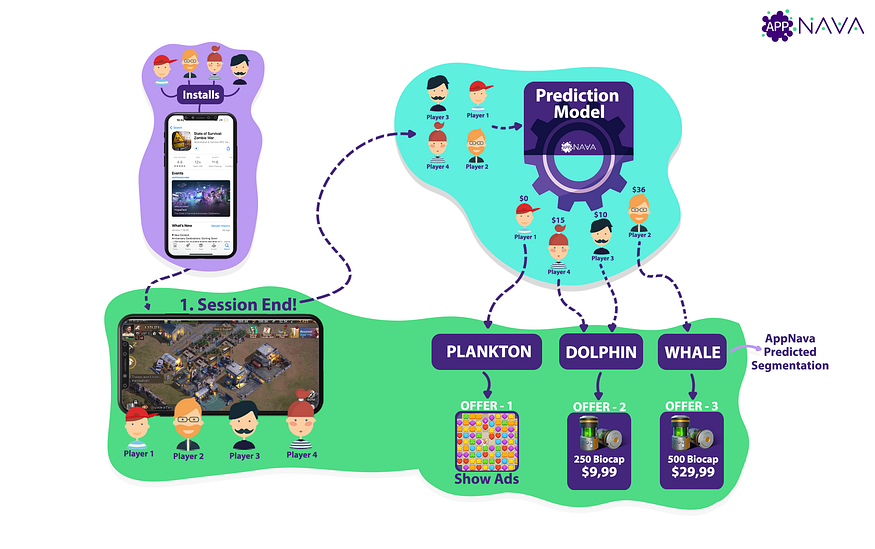1. Introduction
In the dynamic world of gaming, where player engagement is the lifeblood of the industry, harnessing the potential of algorithmic pricing and tailored offers can be a game-changer. Let’s take a closer look at how game companies are using smart pricing and machine learning to turn undecided players into paying customers, all while boosting their revenue.
The key to success? Adaptive Monetization Strategy!
Unlike traditional fixed prices, dynamic pricing adjusts based on players’ play behavior and reactions within the game. This ensures that each player receives an offer tailored to their preferences, creating a win-win scenario for all involved.
2. Understanding Dynamic Monetization Strategy
In gaming, “one-size-fits-all” doesn’t work. Dynamic offers & bundles are the answer. Instead of sticking to fixed prices and content, it adapts to factors like how players engage with the game and how they respond to various in-game elements. This dynamic approach guarantees that every player enjoys a deal perfectly suited to their gaming style, and that’s a win-win for everyone involved.

3. Segmentation and Personalization
A vital component of dynamic monetization is player segmentation.
Machine learning models analyze past player data and behavior, including their gameplay patterns, in-game reactions, and purchase history. With this data, they can swiftly estimate a player’s future Lifetime Value (LTV) or the amount they’re likely to spend on in-app purchases based on their initial gameplay session.
If you don't know how to train ML models or don't know where to start! Check our Auto ML & Segmentation Assistant— AppNava
One crucial factor these algorithms consider is how likely a player is to engage in in-game purchases (IAPs). By meticulously crunching the numbers and evaluating player actions, the algorithm assigns each player a probability score. For instance, a player with a score in the 40% to 60% range finds themselves in the “grey area,” indicating that they’re not entirely against making IAPs, but they’re not entirely committed either.
4. Turning Grey Areas into Gold
Imagine this grey area as a chance to make players happy and increase revenue. Game companies can create special deals and bundles that are hard to resist. These could be discounts, cool in-game stuff, or limited-time offers that match what the player likes.
For instance, if the algorithm says a player has a 55% chance of making an IAP, the game company might offer them a “Starter Pack” with exclusive items and in-game money at a lower price. This makes it more likely the player will make the purchase, and they’ll feel like they got a great deal.
5. Predicting Future Behavior Quickly
Timing is crucial in dynamic pricing. Game companies aim to predict a player’s propensity to make in-game purchases as soon as possible. This predictive power is where machine learning shines.>
This prediction can happen at the end of a player’s first session, upon reaching a certain level, or even within the first day of gameplay.
The goal is to provide personalized offers and pricing as early as possible in the player’s journey.
6. Adapting Offers in Real-Time
What makes machine learning-driven dynamic pricing truly remarkable is its real-time adaptability. As player behavior evolves & shifts, algorithms continuously analyze data to ensure that offers remain relevant and compelling.
Furthermore, gaming companies can gauge the effectiveness of these offers by monitoring KPI’s. If a particular offer proves highly successful, similar promotions can be extended to other players within the grey area or refined for maximum profitability.
7. Enhancing Product Management Success
For product managers in the game industry, knowing which players are likely to make in-game purchases or have a high LTV potential — even before they’ve completed a purchase — is a key success factor.
Armed with this information, product managers can tailor game features, promotions, and offers to target these high-value segments effectively.
In the dynamic world of gaming, understanding player behavior and preferences is the name of the game. Dynamic monetization strategy, driven by machine learning algorithms, empowers gaming companies to achieve precisely that. By identifying high-potential players early in their gaming journey and thoughtfully presenting them with appealing packages and bundles, businesses optimize their revenue streams while enhancing the player experience.
As technology continues to advance and data analysis becomes increasingly sophisticated, the future of dynamic pricing and personalized offers in gaming holds great promise. It’s a win-win scenario where players revel in more customized experiences, and gaming companies reap the benefits with increased revenue — a harmonious blend of player satisfaction and business success.
As a AppNava team, we love diving into the exciting world of gaming and technology. You can find our success story about segmentation; They increased their monthly profitability rates by 22%
Follow us for more insights into how technology is reshaping the gaming landscape.



